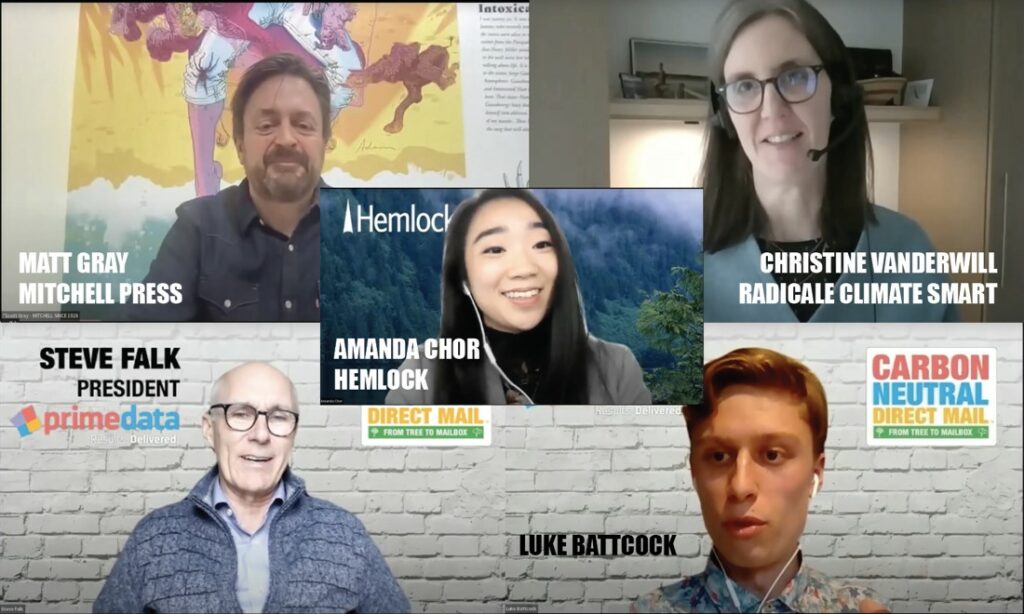Powerful fact:
So how do they tap into it? What’s the key to success? The answer is measurement.
Amanda Chor recently spoke with Christine VanDerwill, Radicale, Climate Smart and Luke Battcock, who are experts in the space and business leaders Scott Gray and Steve Falk during our recent Carbon Footprint Symposium to find out how to get started on measuring carbon emissions and how to maintain that momentum as their emission reduction journey continues.
Here are our top 5 takeaways for companies who want to begin their carbon reduction journey:
- Appoint and train an Exec/Sr Leader and a sustainability program owner to champion the work from the top down and bottom up.
Scott Gray, an EVP at MITCHELL Press, identified an internal champion. He created a hybrid role for them to become an environmental coordinator in front of the house and then took the training with them. Hence, he fully understood how the program worked and could advocate for it effectively.
“What’s important is that you get buy-in from senior leadership from your company, so it’s a top-down approach. Someone in the middle is reporting up and down; it will have some effect but might not be as impactful” – Scott Gray, EVP, MITCHELL Press.
2. Invest in tools to measure your footprint to establish a benchmark and identify opportunities for reductions.
The great news is that there are a lot of different tools out there to help businesses measure and manage their carbon footprint. Climate Smart is a measurement program explicitly scaled for SMBs that combines their measurement software with training for the team that will handle it and has the support they need to ensure the agenda will be successful.
“There’s so much potential to engage small and medium-sized businesses in climate action. They need to be players. They need to be at the table, and that’s really our mission.” – Christine VanDerwill, Radicale, Climate Smart.
- Communicate those opportunities and progress against those efforts internally and externally.
Prime Data is committed to transparency in reporting by making their Carbon Report data open source so other businesses and industry players can learn from their efforts and contribute to the conversation.
“We always wanted to make this information public because we knew we wanted to share what we learned about paper and what was downstream of us is Canada Post, and that was an unknown. As far as we know, we’re the first organization to look at a postal service and see what the GHG emission was from tree to mailbox. It’s there for people to use and hopefully benefit from it and improve their business.” – Steve Falk, President, Prime Data.
- Start slow and build from there. Don’t try and do everything at once.
Getting started doesn’t have to be a complex, operations-wide effort. Look for easy wins first, keep measuring as you go and add additional steps over time.
“If you have a pie-chart of all the greenhouse gas emissions of a mailer from the tree to mailbox, the paper is a very large chunk of it. If the average mailer weighs 20 grams, and you can make it 15 grams, you’ve made a remarkably big difference in the greenhouse gas emission of that piece of mail. Seems like a simple thing, but over time, they really add up.” – Steve Falk, President, Prime Data.
- Stay vigilant for more opportunities to improve through supplier relationships and capital investments.
Once you’ve measured and established emissions benchmarks, it’s much easier to spot opportunities for reductions.
“We had so many different SKUs. We probably had 140 SKUs at that time. Using a strategy based on our measurement data we narrowed down by 60% allowing to go narrow and deep in our inventory. That worked fantastically with our paper suppliers…We also work with mills that are basically at our back door. They’re FSC certified and don’t always have as much recycled content but still have one of the lower carbon footprints for products we use.” – Scott Gray, EVP, MITCHELL Press.

